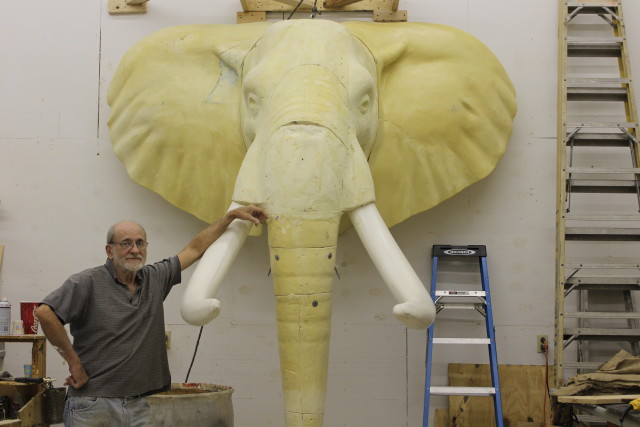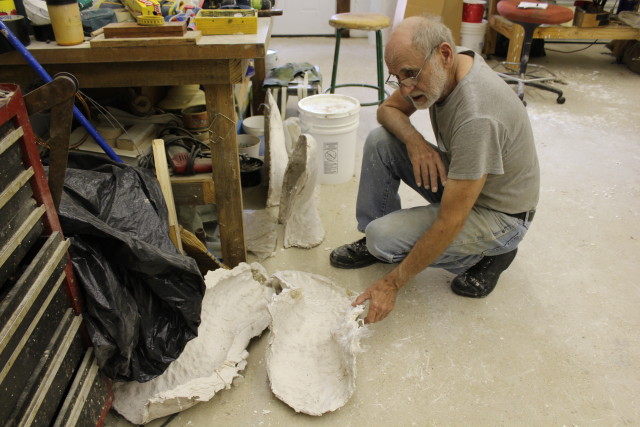Texan Is the Stuff of Legends in the Taxidermy World
By Destinee Reyes
Reporting Texas

Joe Kish poses with his almost complete elephant manikin – once details are adjusted, an elephant skin will be mounted to the manikin. Destinee Reyes/Reporting Texas
SHIRO, Texas — In this small East Texas community sits an unassuming white shed. Its appearance doesn’t hint at what is inside: works of art created by a living legend in the field of taxidermy.
This is Joe Kish’s workshop. A life-size, urethane foam elephant head hangs on one wall, ready for the final touches that will turn it into an impressive trophy. A urethane foam model of a crocodile sits on a table, waiting for Kish to apply the skin.
Kish, 74, is an award-winning taxidermist who has revolutionized the field of taxidermy: he spearheaded the creation of national quality standards, created taxidermy competitions, and created his own taxidermy magazine.
Just last year at Breakthrough magazine’s World Taxidermy and Fish Carving Championships in Springfield, Missouri, he received the lifetime achievement award, becoming only the fourth winner of the honor.
James Poerner, a taxidermist and board member on the Texas Taxidermy Association, said Kish has been honored many times by their industry group.
“Joe is an absolute pioneer in our industry,” he said.
For Kish, it all began in the 1940s.
“From the time I can remember, I was fascinated with animals,” he said.
Kish grew up on a farm about 23 miles from Pittsburgh, Pennsylvania, and always admired the beauty of birds and animals. He asked his father for a rabbit skin several times. His father eventually obliged, and Kish added it to his collections of insects and animal skulls.
When he was 11 years old, during a school trip to the Carnegie Museum of Natural History in Pittsburgh, he was fascinated by the mounted animals in the dioramas. In high school, he took a correspondence course in taxidermy. But it would be a little bit longer for his passion to find its place.
After graduating from Penn Joint High School in Claridge, Pennsylvania, he served three years in the Army. On the way back home from service in Germany, he stopped at the 1964 New York World’s Fair, where he was was impressed by the life-sized dinosaurs on display. He won an apprenticeship at the Carnegie Museum, but was unsatisfied with his first professional experience.
“I was going nowhere,” he said.

Kish shows the clay molds of legs that will be added to the African crocodile manikin he is working on. Destinee Reyes/Reporting Texas
Over the next several years, he moved from state to state. He was a city cop for four years in Albuquerque, but practiced taxidermy on the side. In 1970, he moved to Denver and worked under top taxidermists.
But he was not happy with the low quality of work in the profession, partly because there were no national standards for taxidermists to follow.
“The longer I looked at it,” Kish said, “The more I thought, ‘Man, doesn’t anyone know how to do anything?’”
So Kish decided to host his own competition and convention in Denver. His first event had 125 competitors. Kish also published a magazine, Taxidermy Review.
Kish insisted there was a way to tell when a piece of taxidermy was good or bad, and pushed his standards for excellence: craftsmanship, artistry and anatomical accuracy. Every year, the contestants entering Kish’s competitions got better and better.
Kish never made any money from his innovations, but that was fine by him.
“I fulfilled and satisfied myself,” he said. “I didn’t want to be a businessman; I wanted to be a sculptor,” meaning someone who creates the mannequin, or forms, over which the hide or skin is applied.
His method is exacting. To start a new project, Kish consults an enormous library of reference material that fills a large cabinet in his workshop – books, binders and manila folders on his past projects — to see what’s needed to make his work look as lifelike as possible.
Depending on the animal, he will sculpt the form out of urethane foam — preferred for animals with long hair or patterned hides, such as a crocodile – or clay, which allows him to add anatomical or other details before applying the skin to the form.
It can take a month of eight-hour days for a large animal, such as a crocodile – longer if repeated fittings of the skin are needed.
He’s tackled projects as large as a full-sized elephant.
Twelve years ago, Kish settled in Shiro, after a friend who lived there told him it was time for him to stop moving around. He still does taxidermy for customers and helps other taxidermists when they need his time or expertise. He’s helped mount full-sized elephants at sporting goods stores and even traveled to Taiwan, helping to set up a new natural history museum there.
“He’s very talented in the industry,” said Larry Blomquist, publisher of Breakthrough magazine.
“He turned this entire taxidermy industry around,” Blomquist said. “He was very instrumental in a lot of changes that needed to come.”